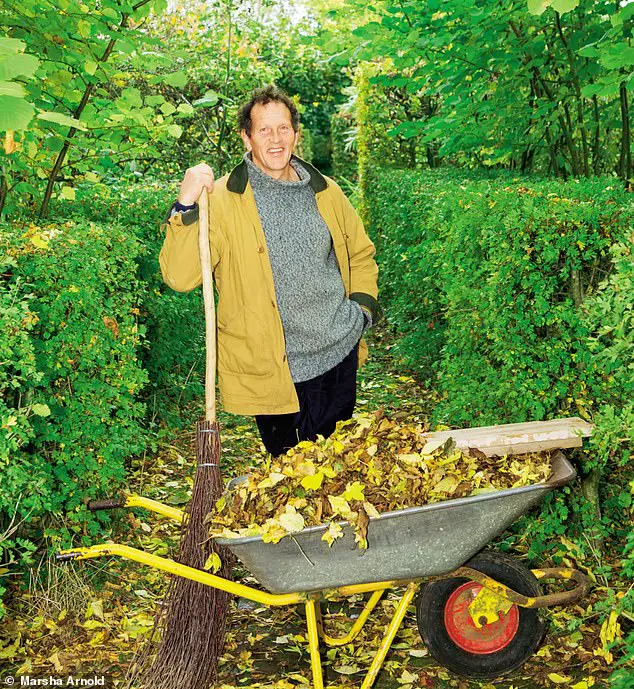Gardening enthusiasts and novices alike are always on the lookout for expert advice to cultivate vibrant and healthy gardens. Renowned horticulturist Monty Don, the beloved host of BBC’s Gardeners’ World, has shared invaluable insights that can transform your gardening experience. From clever propagation techniques to essential seasonal tasks, Monty’s tips are practical, accessible, and designed to help you achieve a flourishing garden.
Whether you’re aiming for bountiful blooms, lush foliage, or a sustainable planting strategy, these 15 amazing tips by Monty Don are sure to inspire you to dig deeper and cultivate your green thumb. Get ready to unlock the secrets to successful gardening and make the most of your outdoor space!
Monty Don’s Tips on Tulip that you should do on October
October may feel like the calm before the winter storm, but according to Monty Don, it’s crunch time for your tulip bulbs! If you want a jaw-dropping spring display, this is the month to roll up your sleeves and get planting. The iconic gardening expert warns that delaying tulip tasks could leave you with disappointing blooms when spring rolls around.
So, what’s Monty’s key advice?
Hold off on planting tulips until later in the month or even November. While it may seem counterintuitive, Monty says that waiting ensures the soil is cool enough to ward off diseases like “tulip fire,” which can destroy your beautiful blooms before they even get a chance. Cooler temperatures are the tulip’s best friend, and timing is everything!

Not only that, but Monty emphasizes the importance of choosing the right spot. Tulips love a sunny location with well-drained soil. Plant your bulbs at a depth of three times their height and with the pointed end facing up. Whether you’re going for a bold tulip-only bed or mixing them with other spring favorites, don’t skimp on spacing – tulips need room to shine.
Don’t panic if you’re planting a little late. Tulips are more forgiving than other spring bulbs, so even if you’re sliding into November, you still have a great chance of a show-stopping garden.
Time to Stop Mowing: Monty Don’s Guide for Prepping Your Lawn Before Winter
As autumn takes hold and temperatures begin to drop, Monty Don advises gardeners to pay close attention to their lawns before the winter season arrives.
One essential task is knowing when to stop mowing. According to Monty and gardening experts like Fiona Jenkins, the final cut should be made between late September and late October, depending on your region’s climate. This is because grass growth naturally slows down as the weather gets colder, and frequent mowing is no longer necessary.

Monty suggests taking the opportunity to repair any worn or patchy areas on your lawn before winter sets in. Whether you’re sowing new grass or laying down turf, autumn is the perfect time to ensure your lawn is in top shape for the upcoming season. Turfing or repairing grass now will give the new growth enough time to establish strong roots before freezing temperatures halt any progress.
Additionally, make sure your lawnmower is cleaned and stored properly once you’ve completed your final cut. With the right preparation in the fall, your lawn will be primed to emerge lush and healthy come spring. So, listen to Monty’s advice and prepare your lawn for a well-deserved winter break.
The First Frost: A Key Indicator for Putting Your Mower Away
One of Monty Don’s top tips for maintaining your lawn as winter approaches is recognizing the key sign to stop mowing: the first frost. Fiona Jenkins, a gardening expert, echoes Monty’s advice, noting that once the first frost hits, it’s time to put your mower away.
This frost is nature’s signal that grass growth will slow significantly or stop altogether, meaning there’s no need for regular mowing. Grass will no longer grow at the rapid pace seen during warmer months, making frequent cuts unnecessary.
Frost not only slows grass growth but also affects the moisture content of your lawn. Mowing after frost can damage both the grass and the mower, as the blades become more fragile. Instead of cutting the lawn, focus on other lawn care tasks, such as clearing leaves and debris to prevent mold or fungi from growing.
Monty’s advice is clear: the first frost signals a natural pause in lawn maintenance. By observing this change, you can prevent overworking your lawn and ensure its health through the colder months. Take this time to store your mower and focus on preparing your garden for a smooth transition into winter.
Transform Fallen Leaves into Nutrient-Rich Leaf Mould
Autumn brings a beautiful array of colors to the garden, but it also leaves behind a significant amount of fallen leaves. Instead of raking them up and discarding them, Monty Don encourages gardeners to embrace this natural resource by transforming them into leaf mold.
Monty describes leaf mold as “garden gold,” a rich organic material that serves as an excellent alternative to store-bought compost. To create leaf mold, gather as many fallen leaves as possible and chop them up using a mower to accelerate the decomposition process.
Next, stack the shredded leaves in an open heap or a DIY leaf mold bin made from four posts and chicken wire.

The ideal size for the bin is at least one cubic meter to allow for adequate aeration. Monty emphasizes that leaf mold not only enriches your soil but also provides essential winter protection for small animals, such as hedgehogs and frogs when piled under hedges and trees.
By utilizing fallen leaves, gardeners can improve their garden’s health and promote biodiversity while minimizing waste. It’s a sustainable practice that benefits both your plants and the local ecosystem, making it a must-try autumn task.
Essential Pruning Techniques for Thriving Climbing Roses
Pruning is a vital task for ensuring the health and beauty of climbing roses, especially as winter approaches. Monty Don advises that the best time to prune these plants is now, as they bloom on shoots developed in spring.
To begin, remove any damaged or crossing growth, as well as very old wood, which can be pruned right back to the ground. The main stems should be fanned out as horizontally as possible and secured to a trellis or wires for stability.

Using sharp tools is essential for effective pruning. Monty stresses the importance of clean cuts, which minimize damage to the plant and promote healthy growth. For thicker stems, loppers are recommended, while a sharp saw should be used for any branches that strain the loppers.
When pruning the side shoots that produced flowers, cut just above a bud that points in the desired direction for new growth. This technique encourages a tracery of horizontal growth and ensures the plant can withstand the winter months. Proper pruning not only enhances the aesthetics of your climbing roses but also sets the stage for a spectacular bloom next spring.
Monty Don’s Tips for Caring for Bare-Root Roses
Monty Don emphasizes the importance of timing and technique when planting bare-root roses, which he regards as a favorite among gardeners.
The ideal planting window for these roses is from November to the end of February, coinciding with their dormant period. This timing ensures that the plants can establish themselves without the stress of active growth.
When ordering bare-root roses, Monty advises gardeners to source them from reputable online retailers or nurseries, as they offer a wider variety than typical garden centers. Upon receiving the plants, it’s crucial to act quickly.
If planting isn’t immediate, he recommends soaking the roots in a bucket of water or “healing in” the roses by burying them temporarily in a trench. This method protects the delicate feeding roots from exposure to air, which can lead to drying and potential plant death.
Monty also highlights that while bare-root roses may require more planning compared to containerized varieties, they are remarkably resilient and forgiving. He encourages gardeners not to be intimidated by the process. With the right approach, planting bare-root roses can be a rewarding experience, leading to vibrant blooms and a flourishing garden.
Essential Pruning Techniques for Climbing Roses This Autumn
As autumn sets in, Monty Don highlights the significance of pruning climbing roses to foster healthy growth and vibrant blooms in the spring.
This essential task helps maintain the structure of the plant and encourages new shoots, which are crucial for flowering. Monty advises beginning the pruning process by removing any damaged, crossing, or old wood that may inhibit growth. Using sharp pruning tools is crucial for making clean cuts, as this minimizes damage and helps prevent disease.
When pruning, the main stems should be spread out as horizontally as possible, and secured to a trellis or wires to allow ample light and air circulation.
Monty suggests cutting side shoots that produced flowers during the previous season back to a short stub, ideally just above a bud that faces the desired direction for new growth. This approach not only rejuvenates the climbing roses but also promotes a beautiful, balanced structure.
Despite the meticulous nature of this task, Monty reassures gardeners that climbing roses are hardy plants. With proper care and attention, they can thrive and continue to be a stunning feature in any garden.
Winter Preparations: Key Tasks to Safeguard Your Garden
With winter approaching, Monty Don urges gardeners to undertake vital preparations to protect their plants from the chilling temperatures and harsh weather conditions. One of the primary tasks is pruning climbing roses, which should be completed before frost sets in.
This action not only maintains the health of the plants but also prevents winter damage, ensuring they are well-positioned for spring growth. In addition to pruning, Monty emphasizes the importance of inspecting the entire garden.
Clearing away fallen leaves and debris is essential to prevent diseases, as these can harbor pests and pathogens over the winter months. Mulching flower beds provide insulation and moisture retention, which is vital for root protection against frost.
Gardeners should also ensure proper drainage to avoid waterlogging, which can be detrimental in colder conditions. For lawns, Monty suggests addressing any worn areas by sowing new grass seed, promoting a lush and vibrant landscape once the weather warms up again.
By taking these proactive steps now, gardeners can safeguard their plants and set the stage for a thriving garden in the spring. Monty’s expert insights remind us that thoughtful winter preparations are key to a successful gardening season ahead.
The Importance of Supporting Main Stems for Healthy Growth
Supporting the main stems of climbing roses is essential for promoting healthy growth and vibrant blooms. Monty Don emphasizes the significance of training these stems to grow horizontally, which helps distribute the plant’s weight evenly and encourages the development of side shoots.
By securing the main stems to a trellis or wires, gardeners create a stable framework that prevents damage from wind or heavy blooms. This support system also enhances sunlight exposure and airflow, reducing the risk of fungal diseases.
When main stems are adequately supported, they can reach their full potential, producing abundant flowers and lush foliage.
This structure allows the rose to focus its energy on blooming rather than struggling to maintain balance. Additionally, well-supported plants are easier to manage and prune, as the defined shape makes it clear where to cut.
Regularly checking the ties and adjusting them as the plant grows is crucial to prevent constriction.
By prioritizing the support of main stems, gardeners can cultivate healthier climbing roses that flourish in any garden, ensuring a stunning display of color and beauty throughout the blooming season.
Essential Steps for Lifting and Storing Dahlia Tubers
To ensure the successful overwintering of dahlias, it’s crucial to properly lift and store the tubers. Begin by waiting until the foliage has been blackened by the first frost, which indicates that it’s time to act.
Use sharp secateurs to cut the flowering stems a few centimeters above the base, then carefully dig up the tubers with a garden fork, being cautious not to damage them in the process. Brush off excess soil with your hands, taking care to avoid bruising the tubers.
After cleaning, hang the healthiest tubers upside down in a cool, dry location for a few days to allow any moisture to escape. Once dried, transfer the tubers into a cardboard box, covering them with dry sand, soil, or compost to prevent rot while maintaining moisture levels.
It’s also wise to label the tubers for easy identification in the spring. Storing them in a cool, frost-free place such as an unheated garage or shed, where temperatures remain stable between 4°C and 10°C, will help protect them from freezing and drying out, ensuring they are ready to thrive come spring.
Best Practices for Overwintering Dahlias in Pots and Borders
Overwintering dahlias can be simplified by taking the right steps, especially for those grown in pots. For potted dahlias, the process begins with relocating the pots to a dark, unheated garage or frost-free shed, ensuring that temperatures do not drop below freezing.
It’s beneficial to reduce the top growth by about half, allowing the compost to dry out completely throughout the winter. During this time, monitor the tubers to ensure they are not exposed to excessive moisture, which can lead to rot.
If your garage tends to get cold, consider insulating the pots with bubble wrap for added protection. For dahlias grown in garden borders, the procedure differs slightly. After the first frost, follow the lifting instructions to extract the tubers while being careful not to bruise them.
Store them in the same way as potted dahlias, ensuring they are labeled. Regardless of the method, keeping the tubers in a cool, dry, and dark environment is key. As spring approaches, you can reintroduce them to warmth, allowing them to awaken and begin the cycle of growth for another blooming season.
Monty Don’s Three Golden Rules for a Bigger Tomato Harvest
Monty Don, the esteemed horticulturist, and BBC Gardeners’ World host emphasizes three essential practices to maximize tomato yield during the peak summer months. His first rule is regular pruning.
Monty advises gardeners to prune their tomato plants weekly, particularly during the summer, by stripping off the bottom half of the leaves. This practice not only allows more sunlight to reach the fruits but also enhances air circulation, reducing the risk of diseases. As the leaves are removed, the plant can redirect its energy from foliage growth to fruit production, resulting in larger, tastier tomatoes.
The second rule focuses on watering. Monty warns against overwatering, which can lead to diluted flavors and potentially crack the skin of the fruit, making them susceptible to diseases. He suggests checking the soil’s moisture regularly, ensuring it is damp but not waterlogged. Adjusting the watering schedule based on weather conditions is crucial for maintaining optimal fruit quality.
Lastly, Monty underscores the importance of fertilization. He recommends weekly applications of liquid seaweed or homemade comfrey feed to enrich the soil. This consistent feeding fosters robust flower and fruit development, setting the stage for a bountiful harvest. Implementing these three golden rules can significantly enhance your summer tomato crop.
Why Pruning is Essential for Healthy Tomato Plants
Pruning is a vital aspect of maintaining healthy tomato plants, and Monty Don highlights its importance in achieving a successful harvest. By regularly removing the lower leaves, gardeners ensure that the plant receives ample sunlight and airflow. This practice not only helps the tomatoes ripen evenly but also prevents the accumulation of moisture that can lead to diseases like blight.
Moreover, pruning encourages the plant to focus its energy on producing fruit rather than excess foliage. Monty suggests that as the season progresses, gardeners can continue this pruning process until the lower leaves are completely removed.
This allows for maximum sunlight exposure on the developing fruits, leading to sweeter and more flavorful tomatoes. Regular pruning also aids in pest management, as fewer leaves mean fewer hiding spots for pests.
By incorporating pruning into their routine, gardeners can significantly enhance the health and productivity of their tomato plants. Monty Don’s approach to pruning not only ensures robust growth but also contributes to a more abundant and higher-quality harvest, making it an essential task for any serious tomato grower.
Cost-Effective Gardening: The Benefits of Plant Propagation
Monty Don’s savvy gardening tip of using smaller plants for propagation is a game-changer for budget-conscious gardeners. Instead of investing in larger, more expensive plants, Monty encourages gardeners to “bulk up” their gardens by purchasing multiple small plants.
This approach not only saves money but also fosters a vibrant garden that can grow together harmoniously. Smaller plants often establish themselves quickly and can create an immediate impact while allowing gardeners to manage their growth more effectively.
Furthermore, as these plants flourish, they can be divided in the future, providing even more opportunities for expansion at minimal cost. By embracing this method, gardeners can enjoy the long-term benefits of a flourishing, diverse garden without the hefty price tag associated with larger, mature plants. Monty’s advice reinforces the idea that thoughtful, economical gardening can lead to stunning results over time.
Key October Tasks for Stunning Foxglove Blooms Next Year
As October unfolds, gardening expert Monty Don highlights the crucial tasks that can ensure your foxgloves will thrive and produce stunning blooms next year. This month is pivotal, especially given the unpredictable weather that can impact plant health.
Monty emphasizes that now is the time for gardeners to focus on preparation, as the right actions taken in the fall can protect plants from winter damage and set the stage for vibrant blooms come spring.
Monty’s advice extends beyond just foxgloves; he also discusses the importance of caring for other plants such as roses, onopordums, and mulleins. For climbing roses, he recommends a hard prune to promote healthy growth.
This involves removing any damaged or crossing stems, along with cutting back old wood to the ground. By fanning out the main stems horizontally and securing them to a trellis, gardeners can mitigate the effects of harsh winter weather while encouraging sideways growth.
Regarding foxgloves, Monty advises gardeners to consider planting or repositioning them in the garden this month. Timing is essential, as most seeds will germinate after the first autumn rains, forming robust rosettes that establish a stout taproot.
This preparation is critical, as foxgloves that germinate in the fall can produce stunning blooms the following year. Monty also encourages the continued planting of spring bulbs, though he advises waiting until next month for tulips. By implementing these key October tasks, gardeners can look forward to a flourishing garden filled with beautiful blooms.
Essential August Task: Take Cuttings for Endless Blooms
In August, as the gardening season reaches its peak, Monty Don emphasizes the importance of one essential task that can significantly enhance your garden: taking cuttings.
This practice not only tidies up your plants but also provides a cost-effective way to create new blooms without spending any money. By propagating plants from cuttings, gardeners can enjoy an abundant garden filled with flowers year after year.
Monty explains that August is an ideal time for taking semi-ripe cuttings from this season’s wood, which has started to harden off.
Healthy plants such as lavender, verbena, hydrangeas, and rosemary are perfect candidates for propagation. The key to successful cuttings lies in selecting strong, straight-growing stems that are free from flowers, disease, and pests. Monty advises potting the cuttings immediately after taking them to ensure they have the best chance of rooting.
When taking cuttings, strip off the lower leaves and side shoots, leaving just an inch or less of foliage. Use a sharp knife or secateurs to cut the stem to size, then bury it in a container filled with gritty compost or perlite.
Maintaining moisture is crucial; Monty suggests daily spraying to prevent the leaves from drying out. In about 4 to 6 weeks, once roots have formed, the cuttings can be transferred to fresh compost and overwintered, ready for planting the following spring. By following Monty’s advice, gardeners can enjoy a beautiful and thriving garden filled with vibrant blooms at little to no cost.






